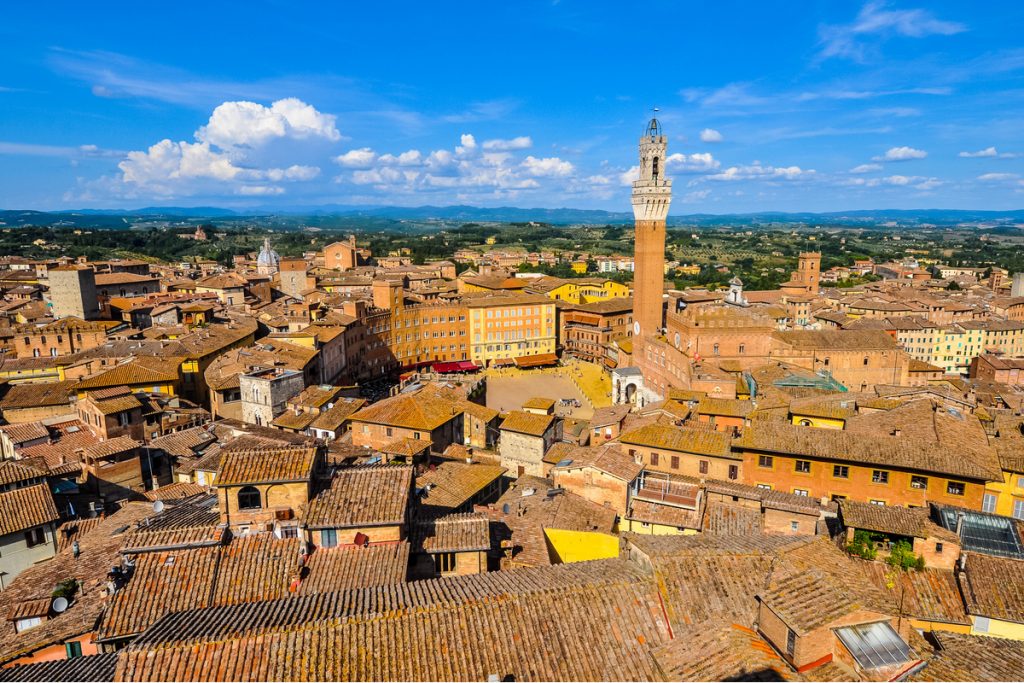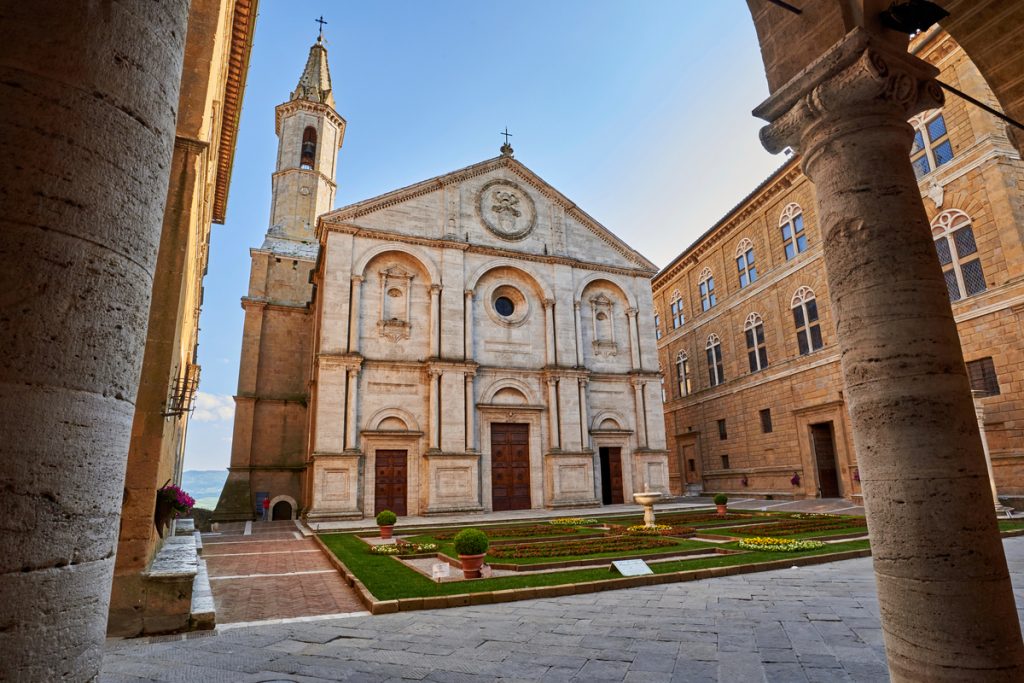Out of 7 Unesco World Heritage sites in Tuscany, 4 are found in the province of Siena. With its remarkable surroundings, it’s the region’s flagship when it comes to natural beauty and Medieval architectural wonders.
Discover amazing sites that are authentic witnesses to the past: from Siena’s historic centre to the magical landscapes of Val d’Orcia, and beautifully preserved towns like San Gimignano and Pienza.

Contents
Unesco World Heritage sites in Siena and its province
1. SIENA HISTORIC CENTRE – “The embodiment of a Medieval city”
If you love Medieval architecture and atmosphere, you’ll fall in love with Siena. With the spectacular shell-shaped Piazza del Campo at its heart, Siena’s town centre is a maze of narrow streets and alleys, beautifully ornate Medieval buildings and art-filled churches.
Siena is one of Italy’s finest examples of perfectly preserved Medieval towns, a place that seems to have travelled through centuries undisturbed. Historical authenticity is what makes this town so special. Siena hasn’t grown much since the 15th century, and the original urban plan has been maintained along with the Gothic style of its public buildings.
=> Discover the 7 Unesco sites in Tuscany

“Siena’s distinctive Gothic style is illustrated by the quintessential Sienese arch that dominates the building’s styles”, explains the Unesco site. “Even when buildings underwent major renovations in the 17th, 18th and 19th centuries (such as the Town Hall, the Chigi-Saracini Palace, and the Marsili Palace respectively), Gothic elements had preference.” (source: Unesco World Heritage site).
The Cathedral is an extraordinary example of Gothic architecture, one of the most beautiful in Italy.
But there’s more. Here the Middle Ages comes to life every Summer, on the occasion of the historic bareback horse race known as the Palio. This is when Siena’s 17 contrade, or districts, act out their ancient rivalries. And of course, at any time of year, one can find traces of the contrade in the colourful coats of arms and symbols like the she-wolf, the dragon and the unicorn – all over town.
=> See all the highlights of Siena
2. SAN GIMIGNANO AND ITS TOWERS – A living reminder of Medieval civilisation
San Gimignano’s famous silhouette is the epitome of the Tuscan Medieval hilltop town. Entering one of its ancient stone gates means stepping back in time, and leaving the 21st century behind altogether.

14 of the original 70 tower houses have survived, and they proudly watch over the stone squares, ancient fountains and wells of the city. While in other Tuscan towns, like Florence, the house towers were converted into palaces during the Renaissance, San Gimignano – that by then had lost its centrality in the region – kept its original feudal look. The towers speak of a time when rival families were in conflict and showing off their power.
Notable 14th century frescoes decorate the interior walls of the Cathedral. As we read on the UNESCO site, “the frescoes by Memmo di Filippuccio commissioned in 1303 to decorate the chambers of the Podestà in the Palazzo del Popolo are among the most frequently reproduced documents used to illustrate daily life of the early 14th century, down to its most domestic details” (source: Unesco site). In all its aspects San Gimignano is a perfect ‘living piece of history’ that everyone can enjoy today.
=> Unmissable things to do in San Gimignano!
=> The Chianti region is candidate for the Unesco Heritage list.

3. VAL D’ORCIA – the beauty of cultural landscape
As you drive south of Siena, you enter a world of idyllic countryside, the Val d’Orcia. This is a land of soothing and magical views, where the lines of cypress trees decorate the perfectly rounded hills, and wheat fields colour the panorama with an intense green in spring and hues of burned yellow in summer.
But the Val d’Orcia is much more than hypnotic natural beauty. It brings with it some valuable memories of the region’s past.
“The Val d’Orcia is an exceptional reflection of the way the landscape was re-written in Renaissance times to reflect the ideals of good governance and create an aesthetically pleasing picture”, explains the Unesco site.
Depicted by painters from the Sienese School, images of the Val d’Orcia, often portray people as living in harmony with nature, and have become iconic symbols of the Renaissance.
Explore the delights of the Val d’Orcia with this Full-Day Tour of Pienza, Montalcino, Montepulciano, leaving from Florence. See the highlights of the Orcia Valley and taste some delicious local cheese and wine!
=> Check out our Scenic drive in the Val d’Orcia
=> 5 Picturesque villages to see in the Val d’Orcia

4. PIENZA – the Renaissance “ideal city”
The life of Pienza started humbly under a different name, Corsignano. This Medieval village had in its destiny changed by its most famous son, Silvio Piccolomini, who became Pope Pio II in 1458.
It was here that Renaissance principles were applied to town planning, when the Pope employed the architect Bernardo Rossellino to transform his birth town and made it into the first ‘ideal city’ in history.
In planning the town, Rossellino followed the teaching of Leon Battista Alberti, the famous humanist architect and philosopher who put down the artistic theories of the Renaissance. Rational design, aesthetic balance provided by geometry, good living principles.
The historic centre of Pienza – and in particular the buildings around the main square Piazza Pio II – represent the first application of the Humanist concept of urban design, and was taken as example for urban development in Italy and beyond.
=> 10 Beautiful Small Towns to Visit near Siena
=> See our 12 Top World Heritage sites in Italy.

The making of Piazza Pio II started around 1459, with the Cathedral, Piccolomini Palace (where the Pope resided), the Episcopal Palace, the Town Hall and the Ammannati Palace. A new main road, Corso Rossellino was created to connect the two main gates in the Medieval walls. The Pope himself contributed to the urban design, planning the construction and restoration of around 40 buildings, public and private, around the town.
Today the historic centre of Pienza has retained its authenticity, and it’s still possible to see the Medieval urban structure as well as the changes made in the Renaissance, including details like the main square’s herringbone paving edged with local travertine. Pienza still stands within its historic boundaries, surrounded by the agricultural landscape of the Val d’Orcia, which looks virtually the same as it did in the 15th century, untouched by modernity and industrial developments.
=> Now that you’ve explored the Unesco World Heritage sites in the Siena province, see all the highlights of Tuscany and 20 Unmissable Experiences to have in Tuscany during your trip!
Disclaimer: Our site contains affiliate links, and when you book one of the sponsored tours or hotels, we get a small percentage, at no additional cost to you! This helps keep the site going, thank you 🙂

